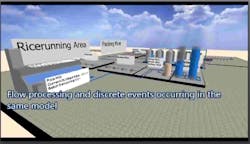Schneider Electric made a bold move last year when it acquired Invensys. The goal: to become a world-class software company. Less than a year later, the company is revealing how the people and products from the two companies are coming together. In a talk with journalists and analysts at the 2014 Software Global Customer Conference in Orlando, Fla., Rob McGreevy, the company’s vice president of information, operations and asset management, discussed the new Software business of Schneider Electric, which encompasses its operations management, asset management and operations integration product lines.
“We’ve always been a software company. We put ourselves on the map with HMI visualization,” said McGreevy about the Wonderware software portfolio acquired in January. “Then we added execution. We added capabilities to control workflow to people. The next thing is smarter systems [and] predictive analytics—recommendations for action based on real-time and historical data.”
For MES and operations management, including MES for batch processes, the trend is toward model-driven tools that are dynamic, easy to configure and scalable to any plant size or geography. “We’ve never had more multisite roll-outs of MES than we have now,” he said.
Operations management software used to be custom-coded, but now it’s configured, McGreevy said. “We’ve made it easier for customers establish their business rules, store them in objects and then enforce them throughout an organization through dynamic user interfaces,” he added.
Wonderware MES 2014 offers a new web-based client and line performance monitoring, as well as advanced recipe and formulation management capabilities for better end-to-end product lifecycle management. Integration with Wonderware Skelta BPM workflow software enables model-driven MES, enforcing production rules and manufacturing procedures.
For cost-effective data management and reporting, Wonderware Online brings a suite of Big Data features in a SaaS package, complemented with a variety of mobile and web-based clients for on-demand analysis.
For food and beverage customers, the company’s new Recipe Manager Plus product speeds product changeover time and reduces the cost complexity associated with new product introductions. Additional capabilities improve food safety, quality and compliance-related activities.
The Avantis asset management product line “uses the same model-based execution engines and applies them to asset management. The same flexibility that an MES customer needs is now available for the asset management community,” McGreevy said.
New workflow functionality provides customers with closed-loop work process management, along with escalation and system of record capture of processes, procedures and activities. A plug-in for Esri’s geographic information system allows customers to view Avantis.PRO information in a map and manage work based on physical locations.
To meet the need for lower cost of ownership and deployment, Avantis.PRO software has also been qualified to operate on virtual machines hosted within the Microsoft Azure environment using the Platform-as-a-Service hosting model.
Convergence and integration is enabling data-driven operations. It is also driving the convergence of information technology (IT) and operations technology (OT), McGreevy said. “This is a Big Data thing. It’s an IoT [Internet of things] thing. It’s a great extension of what we already do.
“As we optimize business systems, it is no surprise that [operations are] becoming data-driven,” he added.
Simio simulation-based scheduling
Beneficial integration can also occur between companies. An example of how users win when Schneider Electric names or trains a partner can be found in its most recent partner-built solution: Simio, LLC is providing Wonderware MES scheduling capabilities.
“When it comes to MES and optimizing production activities, scheduling technology is the jewel on top of an MES solution that a lot of people overlook. This was an area where we wanted to deliver more customer value,” said Tom Troy, director of Operations and Asset Management for Schneider Electric. “We felt this was a good approach to extending optimization capabilities. We’re also complementary to them as they go to market. As they sell simulation, planning and scheduling, we’re providing a tool so their customers can do better.”
Simio 3-D simulation-based planning and scheduling software gives Wonderware MES 2014 software users improved capabilities to determine the best detailed production schedule. It allows asking what-if questions against a model that takes into account equipment availability, raw materials, production capacity and labor resources.
“It allows our customers to easily add a real-time scheduling component, using a rules-based engine and deep simulation. It’s an offering unmatched in the market today,” said Troy.
Rich Ritchie, vice president of sales and marketing for Simio, says, “What we hear repeatedly from prospects is, ‘We like your simulation-based scheduling. We tried it before. But we’re not ready to use it because we can’t get the data needed to drive your models.’” Wonderware MES software delivers the real-time production data in an object-based structure that makes models easier to build, Ritchie said.
The Lockheed Martin F-35 Joint Strike Fighter final assembly line is modeled in Simio, but simulation-based scheduling is just as useful to food and beverage companies, Ritchie added.
Simio differs from traditional scheduling software because it provides planners and master schedulers "a quick way to see their chances or probability percentage of hitting delivery and cost targets, especially after an unexpected situation occurs,” said Dennis Pegden, chief executive officer for Simio. "For example if an important order arrives or a machine breaks down, or workers don’t show up or supplies are late, users can re-run their schedule in minutes, taking into account the recent situation to find the best new production schedule scenario."
“One of the key area that an MES handles is exception management," explains Troy. “We all know the chaos that occurs on the plant floor. Labor, tooling, etc.—there’s always something going wrong. MES brings some order to the chaos. Simio is even better at exception management.”
The 3D visuals offer particular benefits for quicker decision making, because other simulation-based solutions are heavily data-oriented, and users can have difficulty relating to that data, said Pegden.

